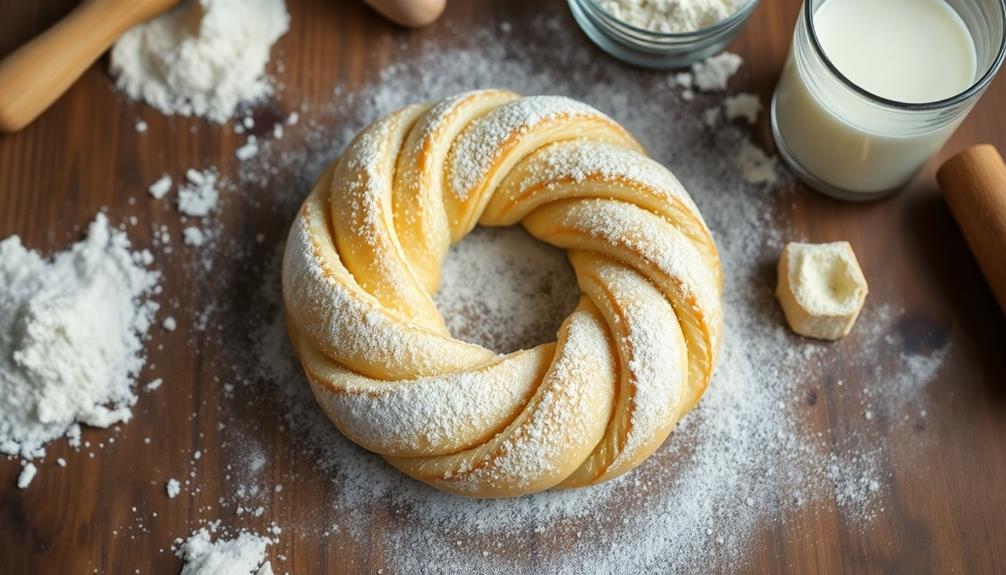Oatmeal is a classic, nourishing breakfast that's simple to make at home. Start by simmering old-fashioned rolled oats in milk – using about 1/2 to 1 cup of oats per serving. Let the oats thicken into a creamy porridge, then stir in your favorite sweeteners like honey or brown sugar. Top it all off with fresh fruit, nuts, or a sprinkle of cinnamon for a delicious, customized oatmeal. This homemade version allows you to control the flavors and textures, making it a wholesome and satisfying way to start your day. There's plenty more to discover about enhancing your oatmeal experience.
Key Takeaways
- A classic and versatile breakfast option, homemade oatmeal allows for customization of flavors and textures to cater to individual preferences.
- The recipe includes simple preparation methods, such as stovetop or slow cooker, and offers options for creamy or chunkier oatmeal.
- Key ingredients for the recipe include rolled oats, milk or non-dairy milk, salt, brown sugar, and vanilla extract, with additional mix-ins and toppings.
- The cooking process involves simmering the oats and milk until the desired creamy consistency is achieved, followed by adding sweeteners and desired toppings.
- Oatmeal is a nutritious choice, providing dietary fiber, sustained energy, and essential vitamins and minerals to support overall health.
History

Beyond Scotland, oatmeal has been embraced by various cultures, each putting their own spin on the classic dish.
In Asia, congee, a savory rice porridge, has ancient roots and shares similarities with oatmeal.
In the American South, grits, a coarse cornmeal porridge, have become a beloved breakfast staple.
Across the globe, the versatility of oatmeal has allowed it to adapt and thrive, nourishing generations of people with its simple, satisfying goodness.
Recipe
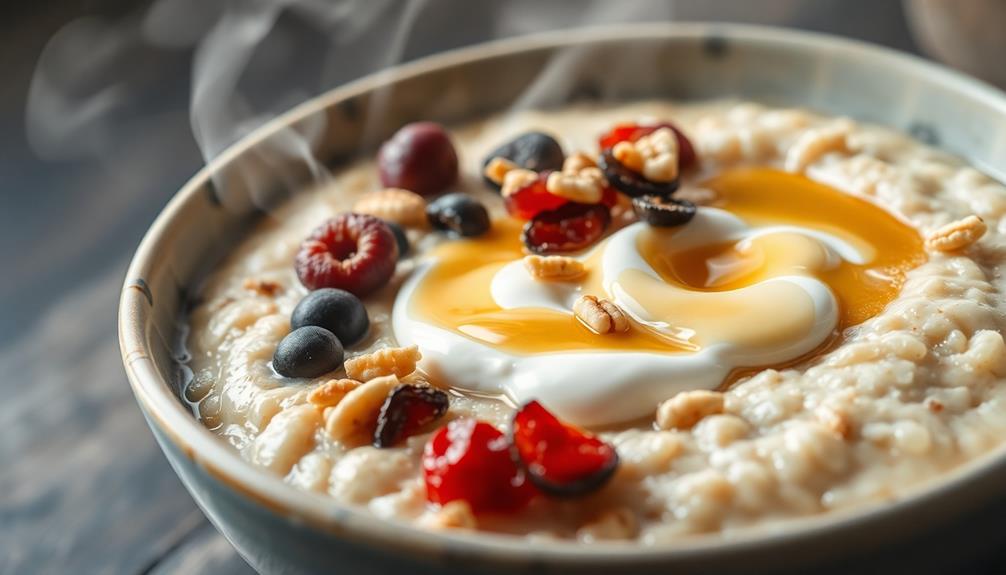
Oatmeal is a classic breakfast staple that offers a delicious and nutritious start to the day. This homemade version allows you to customize the flavors and textures to your liking. Whether you prefer a creamy, comforting bowl or a heartier, chunkier texture, this recipe has you covered.
The beauty of homemade oatmeal lies in its simplicity and versatility. You can experiment with different mix-ins, toppings, and cooking methods to create your perfect bowl of goodness. From a quick and easy stovetop preparation to a slow-simmered version on the stove or in a slow cooker, the possibilities are endless.
Ingredients:
- 1 cup old-fashioned rolled oats
- 2 cups milk or non-dairy milk of your choice
- 1/4 teaspoon salt
- 1 tablespoon brown sugar (or honey, maple syrup, or your preferred sweetener)
- 1/2 teaspoon vanilla extract (optional)
Instructions:
In a medium saucepan, combine the oats, milk, and salt. Bring the mixture to a gentle simmer over medium heat, stirring occasionally, and cook for 5-7 minutes or until the oats are tender and the desired consistency is reached.
Stir in the brown sugar (or other sweetener) and vanilla extract, if using. Adjust the sweetness to your taste.
Tips:
For a creamier texture, use a 1:2 ratio of oats to milk. If you prefer a thicker, chunkier oatmeal, use a 1:1.5 ratio.
You can also experiment with different types of milk, such as almond, coconut, or oat milk, to change up the flavor profile. Additionally, consider adding your favorite toppings, such as fresh fruit, nuts, nut butter, or a sprinkle of cinnamon, to make your homemade oatmeal even more delicious and satisfying.
Cooking Steps
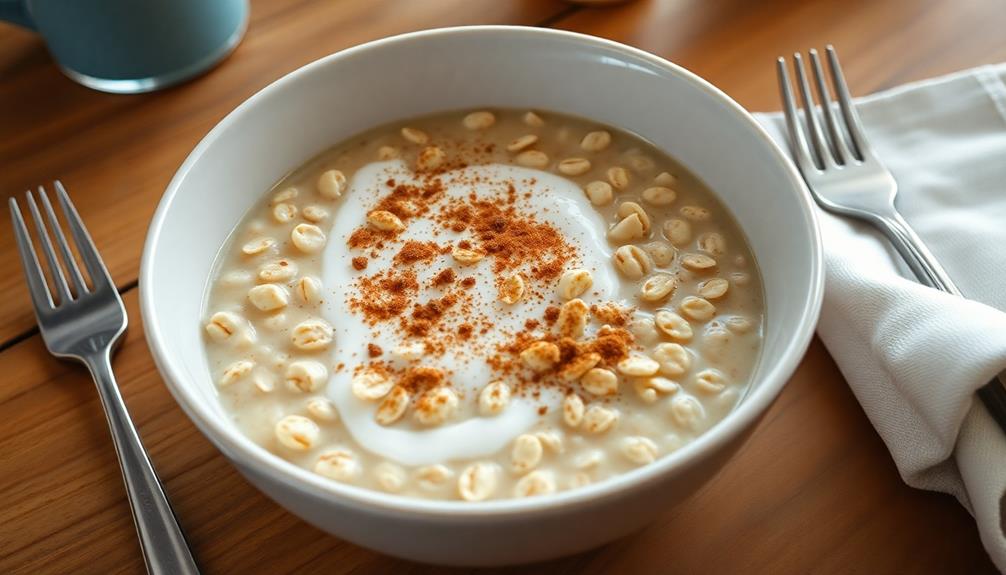
Add the oats and milk to a saucepan and let it simmer until it's thickened, about 5 minutes.
Then, stir in any sweeteners you'd like, top it with your favorite toppings, and enjoy your creamy homemade oatmeal!
Step 1. Add Oats and Milk
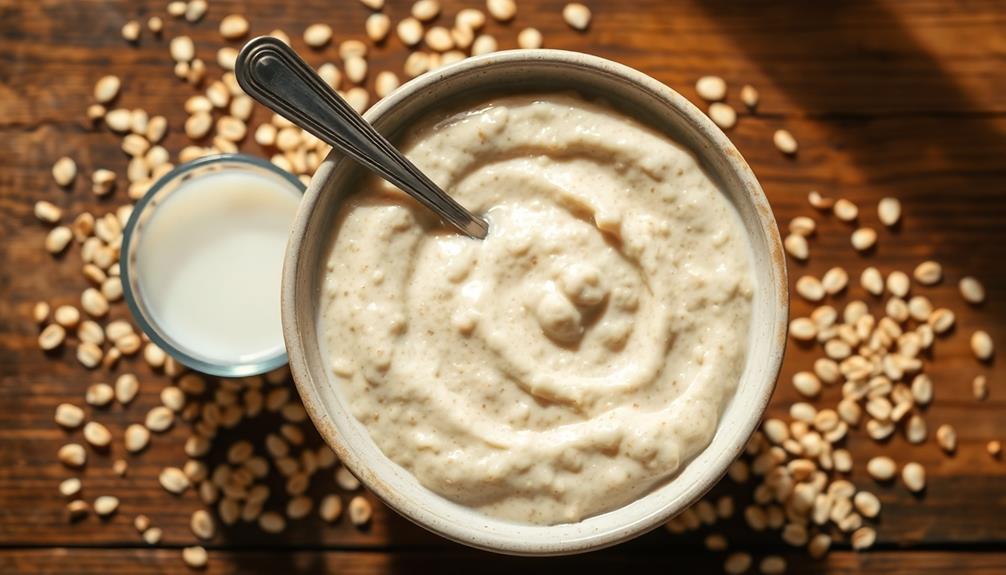
Once you've gathered your ingredients, you'll want to add the oats and milk to your saucepan. Pour in the desired amount of rolled oats, typically 1/2 to 1 cup per serving.
Then, add the corresponding amount of milk – about 1 to 2 cups per 1/2 cup of oats. You can use any type of milk, whether it's dairy, almond, or oat milk.
Stir the oats and milk together gently over medium heat. As the mixture starts to simmer, you'll notice the oats begin to thicken and the milk becomes creamy.
Adjust the heat as needed to maintain a gentle bubble, stirring occasionally to prevent sticking or burning. Keep a close eye on the pot, as oatmeal can go from perfectly cooked to overcooked in a matter of minutes.
Once the oatmeal reaches your desired consistency, usually 5-10 minutes, it's ready to serve and enjoy with your favorite toppings.
Step 2. Simmer Until Thickened, About 5 Minutes
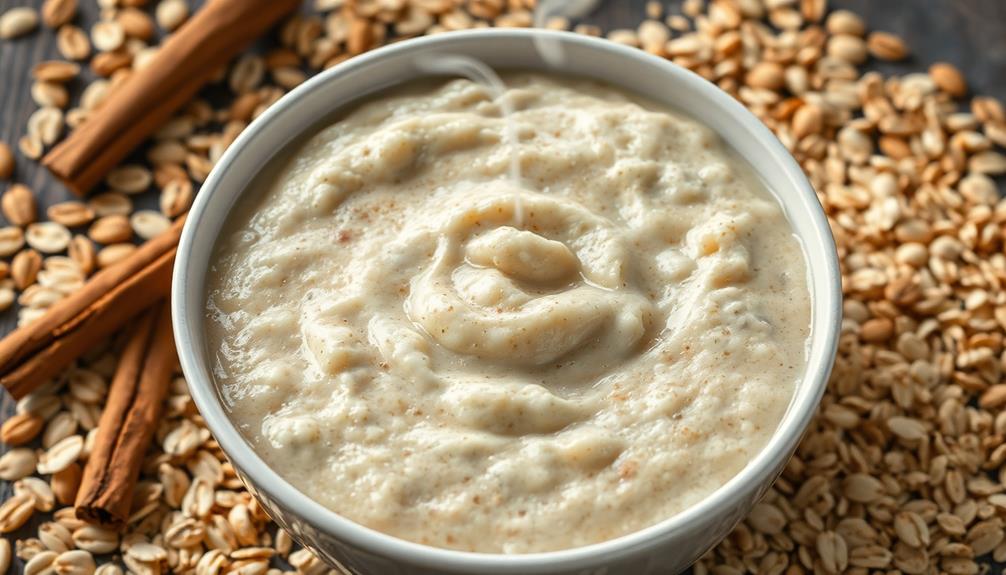
As the oats and milk come together, you'll want to keep a watchful eye on the pot. Bring the mixture to a gentle simmer, reducing the heat as needed to maintain a steady, low bubble.
Stir the oatmeal frequently with a wooden spoon, ensuring all the ingredients incorporate evenly. The oats will gradually thicken, transforming the liquid into a rich, creamy porridge. This process typically takes around 5 minutes, but keep in mind that cooking times may vary depending on the type of oats and the amount of liquid used.
Once the oatmeal has reached your desired consistency, remove the pot from the heat. The oatmeal will continue to thicken slightly as it sits, so don't worry if it appears a bit loose at first.
Adjust the seasoning with a pinch of salt, if desired, and you're ready to enjoy your homemade oatmeal masterpiece.
Step 3. Stir in Desired Sweeteners
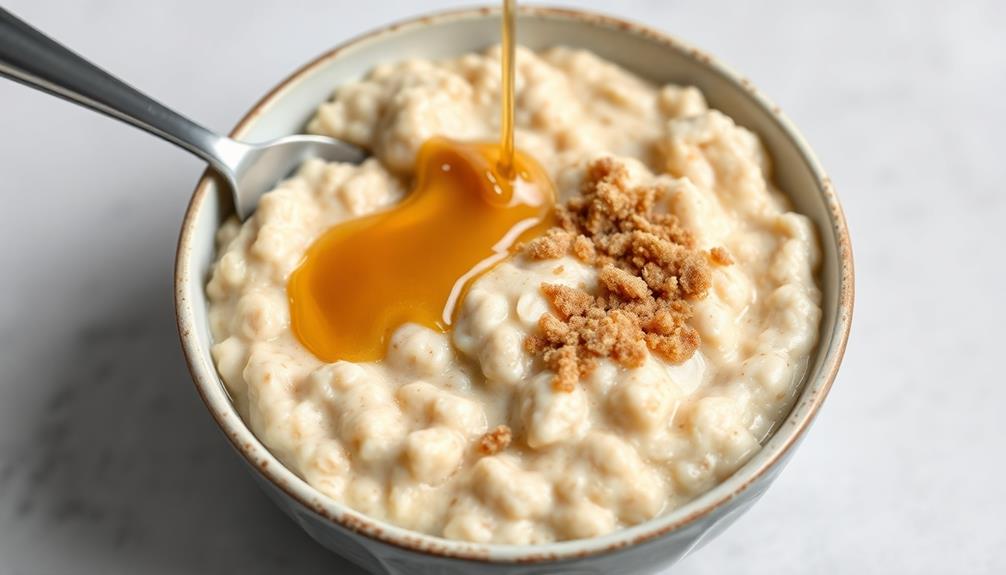
With the oatmeal's rich, creamy texture achieved, you can now stir in your desired sweeteners.
Whether you prefer a touch of honey, a sprinkle of brown sugar, or a drizzle of maple syrup, the choice is yours. Start with a small amount and taste as you go, adjusting to your personal preference. You might even want to try a combination of sweeteners for a unique flavor profile.
Stir the sweetener(s) in gently until they're fully incorporated, ensuring an evenly sweetened oatmeal. Don't be afraid to experiment – the beauty of homemade oatmeal is that you can tailor it to your tastes.
Once you've found your perfect level of sweetness, give the oatmeal a final stir, and it's ready to serve. Enjoy your customized, comforting bowl of oatmeal, perfect for starting your day off right.
Step 4. Top With Desired Toppings

The versatility of homemade oatmeal shines through as you top it with your desired toppings. Chia seeds, known for their ancient nutritional uses, can be a fantastic addition to enhance the nutritional value of your breakfast.
The possibilities are endless – from fresh fruits like berries or bananas to crunchy nuts and seeds. Sprinkle on a touch of cinnamon or a drizzle of honey for natural sweetness.
If you're feeling indulgent, a dollop of peanut butter or a sprinkle of chocolate chips can take your oatmeal to the next level. Don't be afraid to get creative and experiment with different flavor combinations. Maybe you'll discover a new favorite topping you never knew you loved.
The beauty of homemade oatmeal is that you can customize it to your tastes. Take advantage of this opportunity to make your breakfast truly your own.
With a few simple toppings, you can transform a basic bowl of oats into a nourishing and delicious meal that will power you through your day.
Step 5. Enjoy Your Creamy Homemade Oatmeal
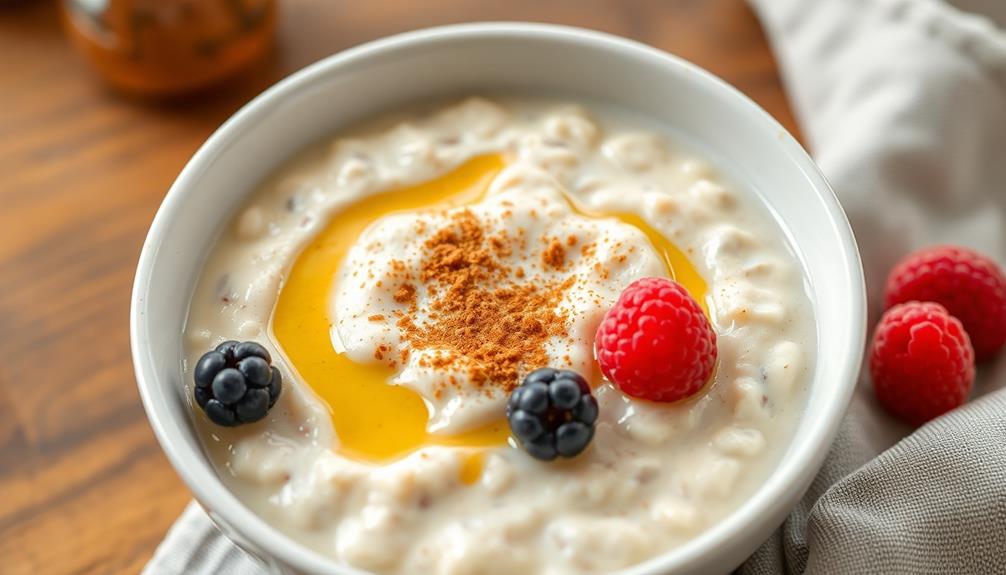
Now that you've experimented with various toppings, it's time to dive into the process of creating your delightfully creamy homemade oatmeal. Start by grabbing your prepared oatmeal and a serving bowl. Spoon the oatmeal into the bowl, being careful not to overfill it.
Inhale the comforting aroma as the warmth envelops the room, creating a soothing atmosphere that can enhance your mood, much like the effects of aromatherapy for emotional well-being.
Grab a spoon and take that first satisfying bite. Allow the creamy texture to melt in your mouth, savoring the flavors you've carefully crafted.
As you continue eating, don't be afraid to adjust the consistency by adding a splash of milk or water if it becomes too thick. Embrace the versatility of this nourishing breakfast, customizing it to your personal taste.
Whether you prefer it thick and hearty or light and fluffy, homemade oatmeal is a rewarding experience that will leave you feeling satisfied and energized for the day ahead.
Final Thoughts
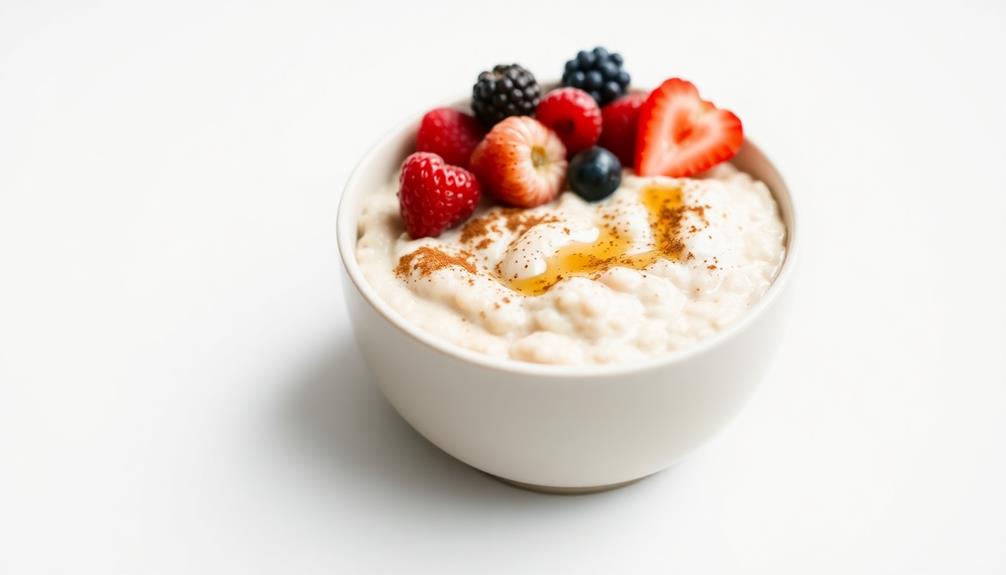
Ultimately, this homemade oatmeal recipe is a simple yet satisfying breakfast option that can be easily customized to suit your preferences.
Whether you prefer a creamy texture or a chunkier consistency, the versatility of this dish allows you to explore different flavor combinations and toppings. Additionally, you might consider pairing your oatmeal with a cup of coffee for added energy, as coffee is linked to improved cognitive function and mood enhancement coffee's health benefits.
Don't be afraid to get creative! Stir in fresh fruit, a sprinkle of cinnamon, or a drizzle of honey to enhance the natural sweetness. The possibilities are endless, so feel free to experiment and find your perfect oatmeal blend.
Enjoy the comforting warmth of this homemade breakfast, knowing that you've taken the time to prepare a nutritious and delicious meal.
With a few simple ingredients and minimal effort, you can start your day off right with a satisfying bowl of oatmeal. Embrace the ritual of cooking this classic dish and savor the wholesome flavors that will fuel you throughout the day.
Frequently Asked Questions
How Can I Make My Oatmeal Creamier?
To make your oatmeal creamier, try using milk instead of water, and add a splash of cream or a spoonful of nut butter. You can also stir in some vanilla extract or honey for extra flavor and richness.
What Are the Best Oats to Use for Creamy Oatmeal?
To make your oatmeal creamier, you'll want to use old-fashioned or steel-cut oats. These heartier oats create a richer, creamier texture compared to quick-cooking or instant oats, which tend to result in a more watery porridge.
Can I Make Creamy Oatmeal Without Milk?
Yes, you can make creamy oatmeal without milk. Try using water, broth, or non-dairy milk alternatives like almond, soy, or oat milk. The key is to cook the oats slowly and stir frequently for a luxuriously creamy texture.
How Do I Prevent My Oatmeal From Getting Too Thick?
To prevent your oatmeal from getting too thick, try adding a bit more liquid like water or milk as you cook it. You can also stir in a splash of cream or butter at the end for a creamy texture.
Can I Reheat Leftover Creamy Oatmeal?
Yes, you can reheat leftover creamy oatmeal. Simply add a splash of milk or water and gently warm it on the stovetop or in the microwave, stirring occasionally, until it reaches your desired consistency.





